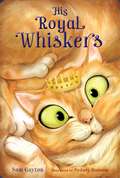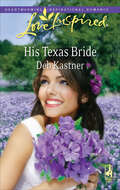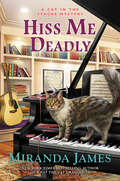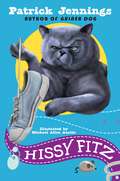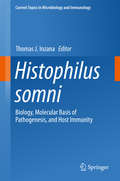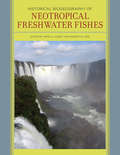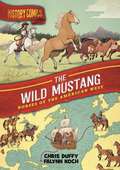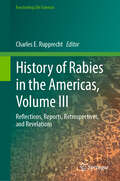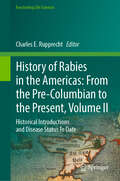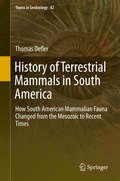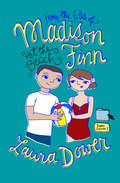- Table View
- List View
His Royal Whiskers
by Sam Gayton Sydney HansonA young alchemist and a giant cat stage a meow-tiny to take down an evil czar in this charming middle grade adventure.Something bad has happened to Prince Alexander, the only heir to the mighty Petrossian Empire. Something worse than kidnapping. Something worse than murder. Somehow, the Prince has been miraculously transformed into a fluffy kitten—and a large one, at that. Giant, in fact. Dinosaur-sized. Why has this terrible catastrophe happened? Who are the boy and girl brewing secret potions down in the palace kitchens? And how are they possibly going to avoid getting their heads chopped off?
His Secret Child (Rescue River #2)
by Lee Tobin McClainIn this wholesome and heartwarming romance, a foster mother takes in a curious stranger—who just might be the missing piece of her little family.Snowed in at the dog rescue farm where she’s housesitting, Fern Easton can’t turn away the handsome stranger who appears during the blizzard. Who is this mysterious man who’s as capable with stray dogs as he is with her four-year-old foster child?Carlo Camden has returned to Rescue River to be a father to a daughter he never knew existed. But he doesn’t expect to stumble upon little Mercedes right away. Let alone to start caring about the beautiful woman who desperately wants to be her mom. Carlo’s surprise homecoming is all about making amends. But he might just have found the woman of his dreams, too . . .
His Texas Bride
by Deb KastnerIt's been years since single father Buck Redmond set foot in his Texas hometown. For good reasons—or so he thinks. He plans to quickly sell his family's ranch and hightail it out with his son. But the Redmond homestead now belongs to his former flame, Ellie McBride. The violet-eyed beauty stirs up all kinds of bittersweet memories—including why Buck left her behind. And she somehow manages to turn his scowling son into a happy, talkative junior cowboy. Soon enough, Buck is reminded of why he loved Ellie. But making her his Texas bride will mean completely opening his heart.
Hiss
by Kirsten MarionWhen a bullied boy is unexpectedly turned into a python, his opportunity for revenge comes with complications.Twelve-year-old Max is a scientist, a pioneer eager to discover the secrets of the universe, a young mind alight with hypotheses and theories waiting to be proven. Too bad nobody—not the bullies at school, the new girl Darya, or worst of all, his own dad—can see it. They only see him as a shy, nerdy kid. If they see him at all.But everything changes when Max transforms into a giant python after an accident in his dad&’s laboratory. He has cool new senses, powerful muscles, and an entirely different perspective to explore. This could be his chance to be strong and courageous!But when rumours of a boy-eating snake go viral and Max&’s animal instincts grow harder to control, Max realizes that being a wild snake in a suburban world is dangerous.If he doesn't find his way back to his true form, he risks losing his humanity forever. But first, he must convince others of his identity and learn to see himself in a new way.Hiss is a story of transformation, overcoming fears, and building relationships.
Hiss & Tell: A Mrs. Murphy Mystery (Mrs. Murphy #31)
by Rita Mae BrownWhen a series of mysterious deaths spoil the Christmas season in Crozet, Virginia, Mary Minor &“Harry&” Harristeen and her beloved cats and dogs lend the police a helping paw in this exciting holiday mystery from Rita Mae Brown and her feline co-author Sneaky Pie Brown.Christmas is coming and Harry&’s to-do list is a mile long. The days are filled with delivering holiday baskets to neighbors in need, chopping down the perfect tree with her best friend, Susan Tucker, and hunting for that elusive special gift for her beloved husband, Pharamond &“Fair&” Harristeen. Harry also decides to try her hand at dog showing, enrolling her handsome Irish Wolfhound puppy Pirate in classes to prepare for a future exhibition. Through it all, holiday cheer—and plenty of treats for Pirate—keep spirits high.But the holidays aren&’t cheerful for everyone. Harry&’s friend on the police force, Cynthia Cooper, warns that the season can bring an uptick in crime. Her words prove tragically prescient when Harry and Susan discover the body of a man by the side of the road, dead, without any clues to his identity. One suspicious death is bad enough, but when Cooper reports that two more bodies have been found, also unidentified, Harry knows trouble is afoot. The autopsies for all three bodies reveal the presence of a deadly drug. Could their deaths have been accidental, or is a devious killer on the prowl?With help from her feline sidekicks, Mrs. Murphy and Pewter, as well as Tee Tucker the corgi and Pirate, Harry vows to find the answers and stop the spate of deaths so that all of Crozet can have a very merry Christmas.
Hiss Me Deadly (Cat in the Stacks Mystery #15)
by Miranda JamesCharlie and Diesel must catch a killer before he strikes another deadly note in this latest installment of the New York Times bestselling Cat in the Stacks Mysteries.Charlie Harris remembers Wilfred &“Wil&” Threadgill as one of the outsiders during high school in Athena. Although Wil was a couple of years ahead of him and his friend Melba Gilley, Melba had a big crush on Wil, who dropped out after his junior year. An aspiring musician, Wil hit the road for California and never looked back. Wil eventually became a star, fronting a band and writing award-winning songs. Coming back to Athena to work for two weeks with students in the college music department, Wil is now the big man on campus. Not everyone is happy to have him back, however. His entourage have been the target of several acts of petty harassment. At first they are easy for Wil to shrug off, but the incidents escalate and become more troubling. When one of the band members is killed Charlie worries that Melba, now deeply involved with the man at the center of the attacks, could be in deadly danger. It is up to Charlie and Diesel to find out who hates Wil Threadgill enough to silence his song . . . forever!
Hiss and Tell
by Pam Johnson-BennettMeet Mambo, the cat who attacks his owner, but only on Sundays, and Bonsai, the cat whose dislike for the new boyfriend becomes very embarrassing. What secret does Freddie know about his owner's new wife? In this offbeat and illuminating book, feline behaviorist Pam Johnson-Bennett, takes you on the wildest house calls of her career. These stories--each of which unfolds like a mystery--will help owners better understand the ever fascinating cat psyche. Following on the success of her comprehensive book, Think Like a Cat, Johnson-Bennett sheds light on the communication breakdowns between cats and their humans. .
Hiss-s-s-s!
by Eric A. KimmelOmar wants a snake more than anything, but his mom is unenthusiastic to say the least. However, the family strikes a compromise: Omar can get a corn snake; but it must stay inside his room, where his mom will not have to set eyes on it. So when Arrow escapes, Omar has to keep it a secret. But with an inquisitive little sister and parents mindful of odd behavior, it's not easy.
Hissy Fitz
by Patrick JenningsA popular middle-grade writer moves to chapter books with this humorous tale about a cat that makes Grumpy Cat seem cheerful. Perfect for fans of Geronimo Stilton and Dog Diaries. Hissy Fitz lives with some two-legged creatures who are destined to serve him in every possible way and understand his every whim. Sadly, these creatures are sorely lacking in their skills. For one thing--they touch him when they want to touch him. Don't they know that the two-legged are there for him to touch when he wants to--meaning when he wants food? Petting wakes him up! They speak to him--don't they know the two-legged should be seen--so Hissy knows where to order food--and not heard?! It's becoming intolerable. What is this irascible cat to do?
Hissy Fitz
by Patrick JenningsHissy Fitz lives with some two-legged creatures who are destined to serve him in every possible way and understand his every whim. Sadly, these creatures are sorely lacking in their skills. For one thing—they touch him when they want to touch him. Don't they know that the two-legged are there for him to touch when he wants to—meaning when he wants food? Petting wakes him up! They speak to him—don't they know the two-legged should be seen (so Hissy knows where to demand food from) and not heard?! It's becoming intolerable. What is this irascible cat to do?
Histoire de baleine
by Catherine F. Daniel S. JanikCette histoire est sur les baleines à bosse du Pacifique. Bien qu'une fantaisie, elle contient néanmoins des informations intéressantes sur ces baleines qui migrent chaque année d'Hawaï vers l'Alaska, et vice-versa.
Histologic Basis of Ocular Disease in Animals
by Bruce Grahn Robert Peiffer Brian WilcockHistologic Basis of Ocular Disease in Animals is a comprehensive reference covering pathology of the eye in a spectrum of animal species, including domestic animals, fish, birds, and laboratory animals. Offers a comprehensive resource on diseases and conditions of the eye and orbit in a wide range of species Covers domestic animals, fish, birds, and laboratory animals Presents more than 1200 high-quality images carefully selected to illustrate the ocular conditions covered Emphasizes unique pathological responses where necessary
Histophilus somni
by Thomas J. InzanaThis volume reviews the current understanding of the taxonomy, disease syndromes, genetics, biology, and pathogenic factors of Histophilus somni, as well as the host immune response to this pathogen. H. somni is one of the most important bacterial pathogens in cattle and other ruminants, and its virulence factors are highly conserved with Haemophilus influenzae and other members of the Pasteurellaceae. H. somni has been recognized as a major cause of thrombotic meningoencephalitis, respiratory disease syndromes, myocarditis, reproductive disease syndromes, polyarthritis, mastitis, ocular disease, and septicemia. The only known habitats of H. somni are the mucosal surfaces of ruminants, making this bacterium an opportunistic pathogen. Although it is capable of causing inflammation at systemic sites and is toxic to epithelial and phagocytic cells, the bacterium's wide array of virulence factors act primarily as a defense against, or to escape recognition from, host innate and adaptive immunity.
Historias Perrunas para decir ¡Guau!
by Sharon KleveHistorias Perrunas para decir ¡Guau! está lleno de tentadoras trivialidades y curiosidades, juegos de palabras y muchos datos sobre cachorros; esta dogo-pedia es una lectura esencial para cualquier amante de los perros. Aprenderás cosas sobre diferentes tipos de perros, razas, personajes... ¡y mucho más! Es un hermoso libro de sobremesa repleto de asombrosas fotografías y divertidos datos; los dueños de perros y fanáticos podrán examinar en profundidad a estos adorables y curiosos amigos de cuatro patas. Levanta las patas si amas todo lo relacionado con los perros, desde su alegría incontenible hasta su lengua babosa.
Historical Animals: The Dogs, Cats, Horses, Snakes, Goats, Rats, Dragons, Bears, Elephants, Rabbits and Other Creatures that Changed the World
by Julia MobergThroughout history, animals have shaped the world as we know it. But rarely have they received the recognition they deserve. Until now.This inside look at history’s most famous animals features wacky verse, cool facts, historical stats, and zany cartoon art. Meet Alexander the Great’s horse Bucephalus, who was his battle companion for nearly 30 years. Learn about Mozart’s starling bird that helped him write music by singing along as he composed. Read about the Ethiopian goats that discovered the coffee bean, Marco Polo seeing dragons in China, and a dog named Boatswain that saved Napoleon’s life. From the cobra that killed Cleopatra to Cairo, the dog that helped hunt down Osama bin Laden, Historical Animals has these stories and more!
Historical Biogeography of Neotropical Freshwater Fishes
by James S. Albert Roberto E. ReisThe fish faunas of continental South and Central America constitute one of the greatest concentrations of aquatic diversity on Earth, consisting of about 10 percent of all living vertebrate species. Historical Biogeography of Neotropical Freshwater Fishes explores the evolutionary origins of this unique ecosystem. The chapters address central themes in the study of tropical biodiversity: why is the Amazon basin home to so many distinct evolutionary lineages? What roles do ecological specialization, speciation, and extinction play in the formation of regional assemblages? How do dispersal barriers contribute to isolation and diversification? Focusing on whole faunas rather than individual taxonomic groups, this volume shows that the area's high regional diversity is not the result of recent diversification in lowland tropical rainforests. Rather, it is the product of species accumulating over tens of millions of years and across a continental arena.
History Comics: Horses of the American West (History Comics)
by Chris DuffyAn American Library Association 2021 Best Graphic Novel for ChildrenTurn back the clock with History Comics, First Second's new nonfiction graphic novel series! In this volume, learn how wild mustangs were first introduced to America and how they still roam free today.On the North American plains, wild mustangs have roamed for generations . . . shaping human history and struggling to survive it. For the Spanish, they were a tool of conquest. For Native Americans, they brought on a new way of life where horsemanship and horse-trading were central. And for the entire world, wild mustangs became a renowned wonder of the American West. There are still thousands of mustangs in the wild today, but they struggle to survive in an ever-changing landscape and their future is by no means guaranteed.
History Comics: The Buffalo's Survival Tale (History Comics)
by Andy HirschAn American Library Association 2021 Best Graphic Novel for ChildrenTurn back the clock with History Comics, First Second's new nonfiction graphic novel series! In this volume, learn how millions of buffalo once roamed the American prairie—until they were nearly driven to extinction.In the early 18th century the American prairies shook under the hooves of nearly 30 million bison. Fast as a horse, tall as a person, and heavier than both combined, they roamed from coast to coast. A century later, people struggled to find a single one left alive. How did the great herds disappear, and what will it take to bring them back?
History and Its Limits: Human, Animal, Violence
by Dominick LacapraDominick LaCapra's History and Its Limits articulates the relations among intellectual history, cultural history, and critical theory, examining the recent rise of "Practice Theory" and probing the limitations of prevalent forms of humanism. LaCapra focuses on the problem of understanding extreme cases, specifically events and experiences involving violence and victimization. He asks how historians treat and are simultaneously implicated in the traumatic processes they attempt to represent. In addressing these questions, he also investigates violence's impact on various types of writing and establishes a distinctive role for critical theory in the face of an insufficiently discriminating aesthetic of the sublime (often unreflectively amalgamated with the uncanny). In History and Its Limits, LaCapra inquires into the related phenomenon of a turn to the "postsecular," even the messianic or the miraculous, in recent theoretical discussions of extreme events by such prominent figures as Giorgio Agamben, Eric L. Santner, and Slavoj Zizek. In a related vein, he discusses Martin Heidegger's evocative, if not enchanting, understanding of "The Origin of the Work of Art." LaCapra subjects to critical scrutiny the sometimes internally divided way in which violence has been valorized in sacrificial, regenerative, or redemptive terms by a series of important modern intellectuals on both the far right and the far left, including Georges Sorel, the early Walter Benjamin, Georges Bataille, Frantz Fanon, and Ernst Jünger. Violence and victimization are prominent in the relation between the human and the animal. LaCapra questions prevalent anthropocentrism (evident even in theorists of the "posthuman") and the long-standing quest for a decisive criterion separating or dividing the human from the animal. LaCapra regards this attempt to fix the difference as misguided and potentially dangerous because it renders insufficiently problematic the manner in which humans treat other animals and interact with the environment. In raising the issue of desirable transformations in modernity, History and Its Limits examines the legitimacy of normative limits necessary for life in common and explores the disconcerting role of transgressive initiatives beyond limits (including limits blocking the recognition that humans are themselves animals).
History of Rabies in the Americas, Volume III: Reflections, Reports, Retrospectives, and Revelations (Fascinating Life Sciences)
by Charles E. RupprechtHistory of Rabies in the Americas, Volume III: Reflections, Reports, Retrospectives, and Revelations is a natural outgrowth of the prior two volumes, which presented topical and spatio-temporal insights on this theme. Volume III offers contributions from those with first-hand experiences with this disease, from groundbreaking discoveries in control and prevention, to the first person to survive rabies without prior vaccination. This volume goes beyond the objectivity of science writing to offer personal narratives detailing individual impacts, the local and global contributions authors have made to detection, prevention, and control, and the long-reaching effects of colonization and disease translocation into this region. The introduction of rabies to the Americas occurred much later than the rest of the world, and the region has played a uniquely pivotal role in global understanding of this disease. Rather than rehashing the topics presented in the first two volumes, Volume III focuses on the leadership role the Americas has played, in the words of those who experienced it first-hand.
History of Rabies in the Americas: Historical Introductions and Disease Status To Date (Fascinating Life Sciences)
by Charles E. RupprechtRabies is one of the oldest known pathogens, is incurable, and has the highest fatality rate of all infectious diseases. The Americas is the only region with bat rabies virus, including vampire bat rabies. The region is rich in cultural references and notable for many discoveries in the field, including the current vaccine potency test, diagnostic assay, conception of oral vaccines for wildlife, the first human survivor and the first successful canine rabies program executed at a broad level. Rabies remains the most important viral zoonosis, with tens of thousands of human fatalities and tens of millions of exposures annually, which can be used to model for other pathogens, such as COVID-19. There is an international effort to eliminate human rabies caused by dogs over the next decade, and the Americas represent the primary region with the greatest proof-of-concept evidence to accomplish this goal. This two-volume set addresses the medical history and modern results of rabies in countries throughout the Americas, including the implications of and on cultural, economic, sociological, and research developments in the region. Volume II provides an in-depth analysis of the rabies' presence and impact in specific countries, including historical perspectives, advances in research and understanding, and current status.
History of Rabies in the Americas: Insights to Specific Cross-Cutting Aspects of the Disease in the Americas (Fascinating Life Sciences)
by Charles E. RupprechtRabies is one of the oldest known pathogens, is incurable, and has the highest fatality rate of all infectious diseases. The Americas is the only region with bat rabies virus, including vampire bat rabies. The region is rich in cultural references and notable for many discoveries in the field, including the current vaccine potency test, diagnostic assay, conception of oral vaccines for wildlife, the first human survivor and the first successful canine rabies program executed at a broad level. Rabies remains the most important viral zoonosis, with tens of thousands of human fatalities and tens of millions of exposures annually, which can be used to model for other pathogens, such as COVID-19. There is an international effort to eliminate human rabies caused by dogs over the next decade, and the Americas represent the primary region with the greatest proof-of-concept evidence to accomplish this goal. This two-volume set addresses the medical history and modern results of rabies in countries throughout the Americas, including the implications of and on cultural, economic, sociological, and research developments in the region. Volume I presents an overview of concepts critical to the study of rabies in the region, including evolutionary aspects, reservoir ecology and control, elimination efforts, vaccine development, and disease hallmarks and progression. It also analyzes the long-term cultural, social, and economic impacts of the disease in the Americas.
History of Terrestrial Mammals in South America: How South American Mammalian Fauna Changed From The Mesozoic To Recent Times (Topics in Geobiology #42)
by Thomas DeflerThis book takes a non-technical approach in covering the evolution of South American mammalian fauna throughout geological history, and discusses how South America has changed due to mammalian invasions. Unlike other works on the subject, this book attempts to answer several crucial questions that often go unmentioned together in one cohesive monograph. What was the fauna like before the American interchange? What were the origins of the now-extinct groups when northern species arrived and out-competed them? How did the modern mammalian fauna come into being with such disparate animal groups? This information is given from a historical perspective throughout the book's 15 chapters, and is presented in an easily graspable fashion by mostly avoiding technical language. The book is written for academics, scientists and scholars engaged in paleontology, zoology and evolutionary biology, but may also appeal to a larger audience of general readers interested in mammalian evolution. The book begins with an introduction, describing the tools necessary to interpret the evolutionary history of South American mammals in geological terms and some of the early people who helped found South American mammalian paleontology. Chapter 2 describes the Mesozoic first mammals of Gondwana and what we are learning about them, dominant before the K/T extinction event. Then chapters 3 through 8 cover the Cenozoic, or "Age of Mammals", highlighting the major mammalian groups of South America that replaced the earlier mammals of Gondwana. These groups include the marsupials, native ungulates, the xenarthrans (armadillos, anteaters, sloths), the caviomorphs (rodents), and the platyrrhine monkeys. Chapters 9 and 10 address the Antarctic La Meseta fossils and the Colombian La Venta fossil faunal assemblages. Chapter 11 discusses the neotropical mammals that invaded the Caribbean Islands, and illustrates the influence South America has had on adjacent faunas. Chapter 12 describes the origin of the Amazon River and the role it has played in the evolution of the mammals and other flora and fauna. Chapter 13 tells the story of the Great American Biotic Interchange (GABI), and chapter 14 follows this up with a discussion of the Pleistocene mammal communities and their eventual extinction. Chapter 15 concludes the text by discussing the modern mammals of South America, and how despite the extensive Pleistocene extinctions there is still a lot of mammalian diversity in South America.
History of the World in 100 Animals
by Simon BarnesA powerful and fascinating insight into the 100 animals - from the blue whale to the mosquito - that have had the biggest influence on humanity through the ages. We are not alone. We are not alone on the planet. We are not alone in the countryside. We are not alone in cities. We are not alone in our homes. We are humans and we love the idea of our uniqueness. But the fact is that we humans are as much members of the animal kingdom as the cats and dogs we surround ourselves with, the cows and the fish we eat, and the bees who pollinate so many of our food-plants. In The History of the World in 100 Animals, award-winning author Simon Barnes selects the 100 animals who have had the greatest impact on humanity and on whom humanity has had the greatest effect. He shows how we have domesticated animals for food and for transport, and how animals powered agriculture, making civilisation possible. A species of flea came close to destroying human civilisation in Europe, while the slaughter of a species of bovines was used to create one civilisation and destroy another. He explains how pigeons made possible the biggest single breakthrough in the history of human thought. In short, he charts the close relationship between humans and animals, finding examples from around the planet that bring the story of life on earth vividly to life, with great insight and understanding. The heresy of human uniqueness has led us across the millennia along the path of destruction. This book, beautifully illustrated throughout, helps us to understand our place in the world better, so that we might do a better job of looking after it. That might save the polar bears, the modern emblem of impending loss and destruction. It might even save ourselves.
Hit the Beach (From the Files of Madison Finn Super Edition #2)
by Laura DowerMaddie is going away for the summer—will her friendships back home stay intact?It&’s summertime in Far Hills and everyone has different plans. Aimee is staying home for her big dance performance; Lindsay is going to London with her dad; Fiona is going back to her hometown in California to visit family and friends; and Madison is going to an environmental camp in Florida. Two weeks away from one another feels like an eternity to the four BFFs. So they come up with the perfect solution: They&’ll keep a blog to stay up to date on one another&’s lives. That way, Maddie can tell her friends all about saving the turtles at Camp Sunshine—and about the new boy she meets at camp. Will is really cute, but Maddie has a crush on Hart, and only Hart—right?Hit the Beach takes place after the Files of Madison Finn, Book 20: All That Glitters and before the Files of Madison Finn, Book 21: Forget Me Not.
